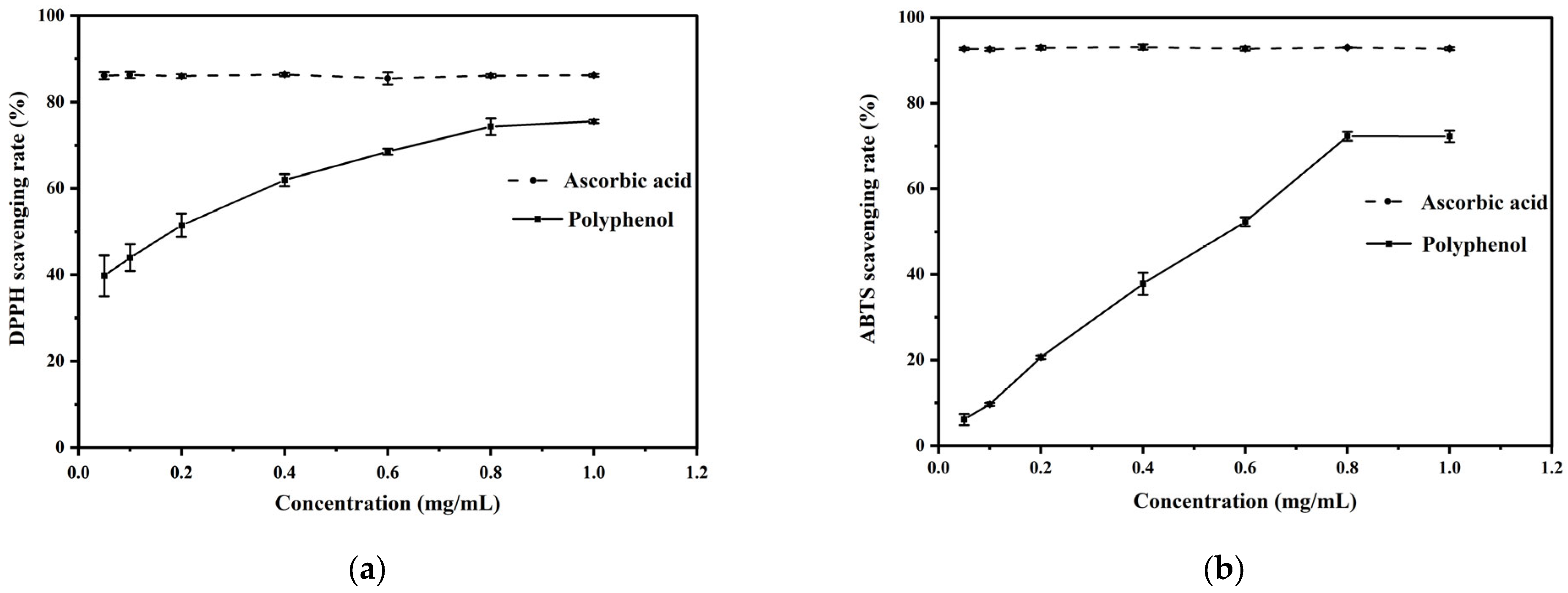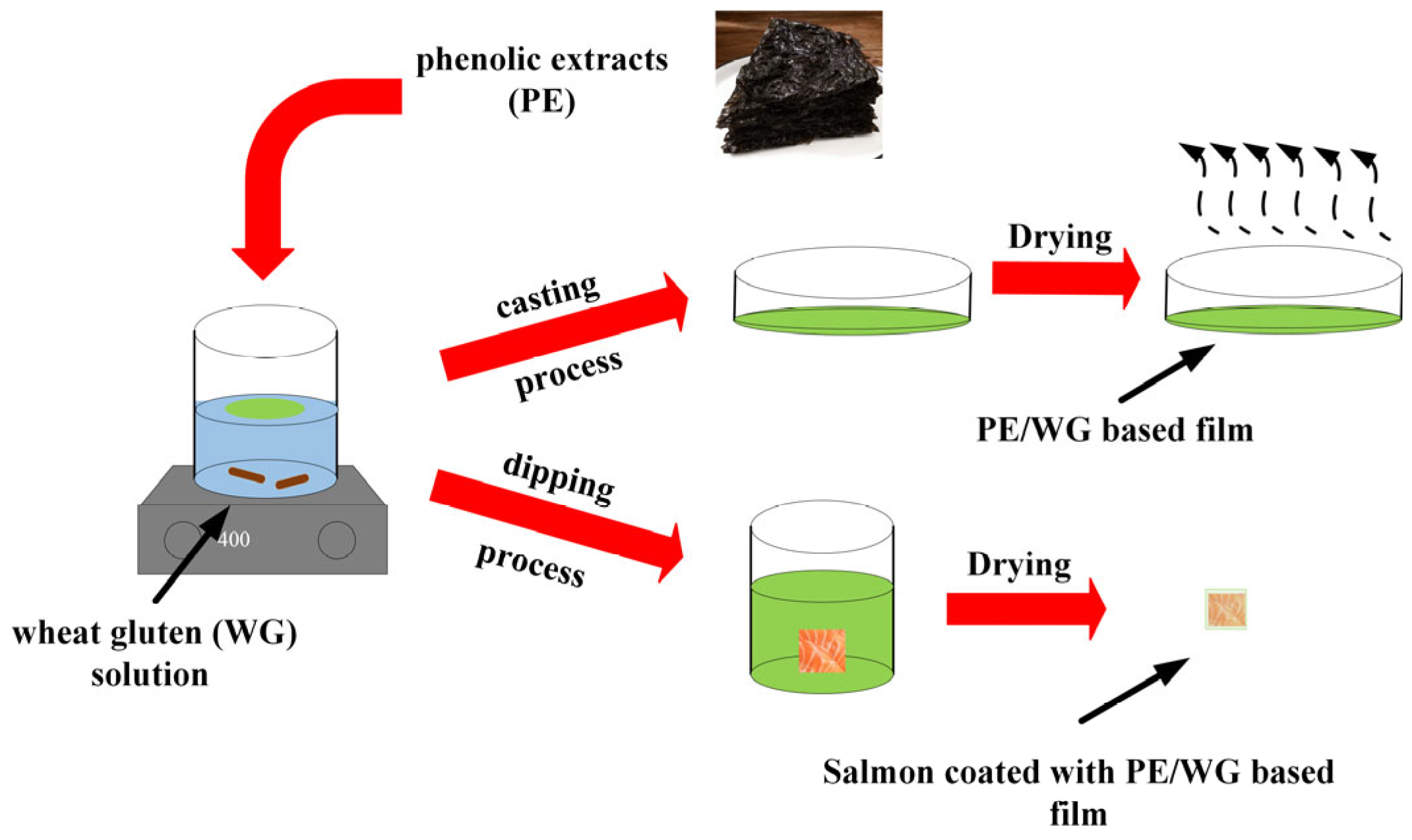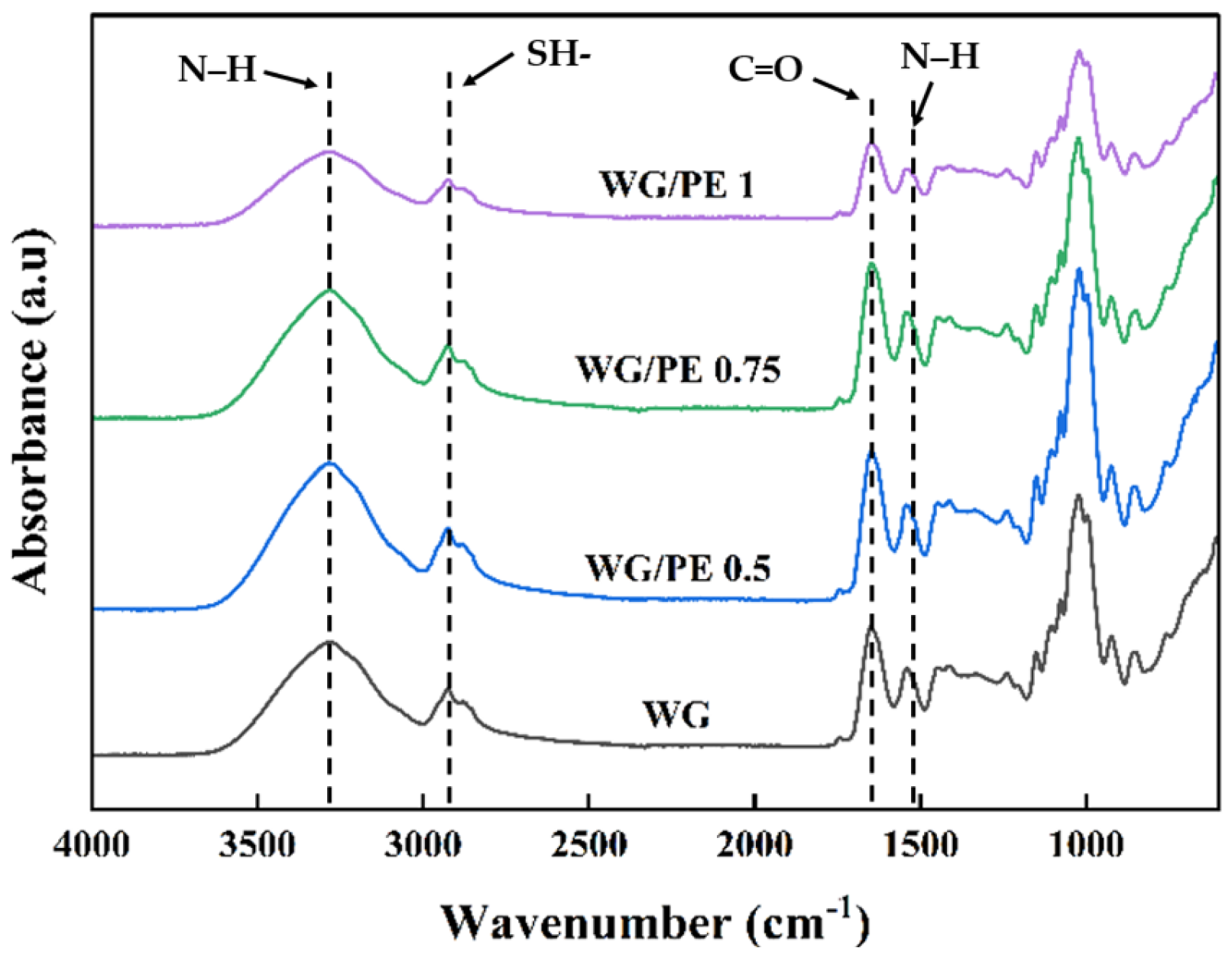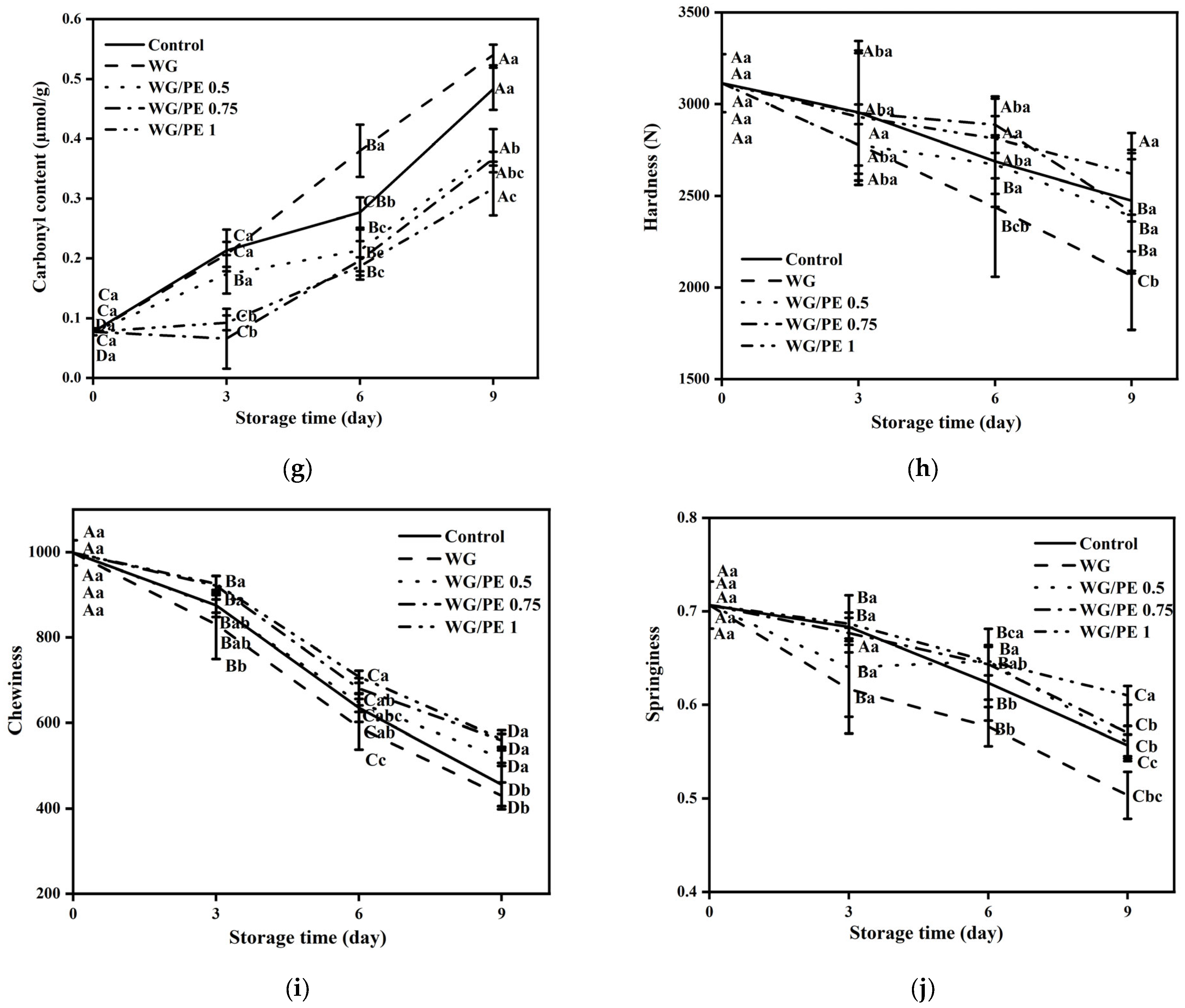Characteristics of Films Prepared from Wheat Gluten and Phenolic Extracts from Porphyra haitanensis and Its Application for Salmon Preservation
Abstract
:1. Introduction
2. Materials and Methods
2.1. Materials
2.2. Phenolic Compounds Extraction from Porphyra haitanensis and Characterization of Antioxidant Activities
2.3. Wheat Gluten/Phenolic Extracts-Based Film Preparation
2.4. Characterization of Film
2.4.1. Color Measurement and Opacity Value
2.4.2. Thickness
2.4.3. Water Vapor Permeability (WVP)
2.4.4. Tensile Strength (TS)
2.4.5. FTIR
2.5. Quality Changes in Salmon Fillet Packed with WG/PE
2.5.1. Preparation and Storage of Salmon Fillet
2.5.2. pH
2.5.3. Total Volatile Basic Nitrogen (TVB-N)
2.5.4. Thiobarbituric Acid (TBA)
2.5.5. Estimation of Peroxide Value (PV)
2.5.6. Water Holding Capacity (WHC)
2.5.7. Determination of Total Sulfhydryl Content
2.5.8. Determination of Carbonyl Content
2.5.9. Texture Analysis
2.6. Statistical Analysis
3. Results
3.1. Antioxidant Activities of Phenolic Extracts
3.2. Film Properties
3.2.1. Color Measurement and Opacity Value
3.2.2. Thickness, WVP, and TS
3.2.3. FTIR Analysis
3.3. WG/PE on Salmon Fillet
3.3.1. pH
3.3.2. TVB-N
3.3.3. Thiobarbituric Acid (TBA)
3.3.4. PV
3.3.5. WHC
3.3.6. Total Sulfhydryl Content
3.3.7. Carbonyl Content
3.3.8. Textural Profile Analysis
4. Discussion
5. Conclusions
Author Contributions
Funding
Institutional Review Board Statement
Informed Consent Statement
Data Availability Statement
Conflicts of Interest
References
- Xu, J.; Manepalli, P.H.; Zhu, L.; Narayan-Sarathy, S.; Alavi, S. Morphological, barrier and mechanical properties of films from poly (butylene succinate) reinforced with nanocrystalline cellulose and chitin whiskers using melt extrusion. J. Polym. Res. 2019, 26, 188. [Google Scholar] [CrossRef]
- Xu, J.; Manepalli, P.H.; Zhu, L.; Narayan-Sarathy, S.; Alavi, S. Morphological and performance characteristics of nanocomposite films based on poly(lactic acid) compounded with nanocrystalline cellulose and chitin whiskers using melt extrusion. Cellulose 2020, 27, 7523–7534. [Google Scholar] [CrossRef]
- Nath, P.C.; Sharma, R.; Debnath, S.; Sharma, M.; Inbaraj, B.S.; Dikkala, P.K.; Nayak, P.K.; Sridhar, K. Recent trends in polysaccharide-based biodegradable polymers for smart food packaging industry. Int. J. Biol. Macromol. 2023, 253, 127524. [Google Scholar] [CrossRef] [PubMed]
- Lou, L.; Chen, H.; Zhang, L. Biodegradable gelatin/pectin films containing cellulose nanofibers and biguanide polymers: Characterization and application in sweet cherry packaging. Int. J. Biol. Macromol. 2024, 274, 133530. [Google Scholar] [CrossRef] [PubMed]
- Xu, J.; Li, Y. Wheat gluten-based coatings and films: Preparation, properties, and properties, and applications. J. Food Sci. 2023, 88, 582–594. [Google Scholar] [CrossRef] [PubMed]
- Hu, F.; Song, Y.Z.; Thakur, K.; Zhang, J.G.; Khan, M.R.; Ma, L.Y.; Wei, Z.J. Blueberry anthocyanin based active intelligent wheat gluten protein films: Preparation, characterization, and applications for shrimp freshness monitoring. Food Chem. 2024, 453, 139676. [Google Scholar] [CrossRef] [PubMed]
- Andrade, J.; González-Martínez, C.; Chiralt, A. Antimicrobial PLA-PVA multilayer films containing phenolic compounds. Food Chem. 2022, 375, 131861. [Google Scholar] [CrossRef]
- Xu, J.; Li, Z.; Zhao, Y. Phenolic compounds of “blue food” Porphyra haitanesis: Chemical fingerprints, antioxidant activities, and in vitro antiproliferative activities against HepG2 cells. Food Res. Int. 2022, 162, 112139. [Google Scholar] [CrossRef] [PubMed]
- Chen, Y.; Li, Y.; Qin, S.; Han, S.; Qi, H. Antimicrobial, UV blocking, water-resistant and degradable coatings and packaging films based on wheat gluten and lignocellulose for food preservation. Compos. Part B 2022, 238, 109868. [Google Scholar] [CrossRef]
- Liang, S.; Wang, L. A natural antibacterial-antioxidant film from soy protein isolate incorporated with cortex phellodendron extract. Polymers 2018, 10, 71. [Google Scholar] [CrossRef]
- GB 5009.228-2016. Method for Analysis of Hygienic Standard of Fish and Other Aquatic Products. Available online: https://www.chinesestandard.net/PDF.aspx/GB5009.228-2016 (accessed on 14 March 2023).
- Niu, F.; Ju, M.; Du, Y.; Wang, M.; Han, X.; Chen, Q.; Zhang, B.; Ritzoulis, C.; Pan, W. Changes in properties of nano protein parcles (NPP) of fish muscle stored at 4 °C and its application in food quality assessment. LWT 2022, 155, 112968. [Google Scholar] [CrossRef]
- Zhang, B.; Liu, Y.; Wang, H.; Liu, W.; Cheong, K.; Teng, B. Effect of sodium alginate-agar coating containing ginger essential oil on the shelf life and quality of beef. Food Control 2021, 130, 108216. [Google Scholar] [CrossRef]
- Hafezparast-Moadab, N.; Hamdami, N.; Dalvi-Isfahan, M.; Farahnaky, A. Effects of radiofrequency-assisted freezing on microstructure and quality of rainbow trout (Oncorhynchus mykiss) fillet. Innov. Food Sci. Emerg. Technol. 2018, 47, 81–87. [Google Scholar] [CrossRef]
- Li, Y.; Tang, Z.; Lu, J.; Cheng, Y.; Qian, F.; Zhai, S.; An, Q.; Wang, H. The fabrication of a degradable film with high antimicrobial and antioxidant activities. Ind. Crops Prod. 2019, 140, 111692. [Google Scholar] [CrossRef]
- Thivya, P.; Bhosale, Y.K.; Anandakumar, S.; Hema, V.; Sinija, V.R. Study on the characteristics of gluten/alginate-cellulose/onion waste extracts composite film and its food packaging application. Food Chem. 2022, 390, 133221. [Google Scholar] [CrossRef] [PubMed]
- Denavi, G.A.; Pérez-Mateos, M.; Añón, M.C.; Montero, P.; Mauri, A.N.; Gómez-Guillén, M.C. Structural and functional properties of soy protein isolate and cod gelatin blend films. Food Hydrocoll. 2009, 23, 2094–2101. [Google Scholar] [CrossRef]
- Georget, D.M.R.; Belton, P.S. Effect of temperature and water content on the secondary structure of wheat gluten studied by FTIR spectroscopy. Biomacromolecules 2006, 7, 469–475. [Google Scholar] [CrossRef] [PubMed]
- Zhang, M.; Song, F.; Wang, X.L.; Wang, Y.Z. Development of soy protein isolate/waterborne polyurethane blend films with improved properties. Colloids Surf. B Biointerfaces 2012, 100, 16–21. [Google Scholar] [CrossRef] [PubMed]
- Ahmad, M.; Nirmal, N.P.; Danishi, M.; Chuprom, J.; Jafarzedeh, S. Characterization of composite films fabricated from collagen/chitosan and collagen/soy protein isolate for food packaging applications. RSC Adv. 2016, 6, 82191–82204. [Google Scholar] [CrossRef]
- Aghababaei, A.; Maftoonazad, N.; Elhamirad, A.; Badii, F. Accelerated ageing of wheat grains: Part II-influence on thermal characteristics of wheat starch and FTIR spectroscopy of gluten. J. Cereal Sci. 2017, 77, 157–165. [Google Scholar] [CrossRef]
- Xiong, Y.; Kamboj, M.; Ajlouni, S.; Fang, Z. Incorporation of salmon bone gelatine with chitosan, gallic acid and clove oil as edible coating for the cold storage of fresh salmon fillet. Food Control 2021, 125, 107994. [Google Scholar] [CrossRef]
- Firdous, A.; Ringø, E.; Elumalai, P. Effects of green tea- and amla extracts on quality and melanosis of Indian white prawn (Fenneropenaeus indicus, Milne Edwards, 1837) during chilled storage. Aquac. Fish. 2021, 6, 617–627. [Google Scholar] [CrossRef]
- Nilsuwan, K.; Guerrero, P.; Caba, K.D.L.; Benjakul, S.; Prodpran, T. Fish gelatin films laminated with emulsified gelatin film or poly(lactic) acid film: Properties and their use as bags for storage of fried salmon skin. Food Hydrocoll. 2021, 111, 106199. [Google Scholar] [CrossRef]
- Wang, R.; Hu, X.; Agyekumwaa, A.K.; Li, X.; Xiao, X.; Yu, Y. Synergistic effect of kojic acid and tea polyphenols on bacterial inhibition and quality maintenance of refrigerated sea bass (Lateolabrax japonicus) fillets. LWT 2021, 137, 110452. [Google Scholar] [CrossRef]
- Shahidi, F.; Zhong, Y. Lipid oxidation and improving the oxidative stability. Chem. Soc. Rev. 2010, 39, 4067–4079. [Google Scholar] [CrossRef] [PubMed]
- Cao, Y.; Zhao, L.; Huang, Q.; Xiong, S.; Yin, T.; Liu, Z. Water migration, ice crystal formation, and freeze-thaw stability of silver carp surimi as affected by inulin under different additive amounts and polymerization degrees. Part A Food Hydrocoll. 2021, 124, 107267. [Google Scholar] [CrossRef]
- Qi, M.; Yan, H.; Zhang, Y.; Yuan, Y. Impact of high voltage prick electrostatic field (HVPEF) processing on the quality of ready-to-eat fresh salmon (Salmo salar) fillets during storage. Food Control 2022, 137, 108918. [Google Scholar] [CrossRef]
- Wu, J.; Li, C.; Li, L.; Yang, X.; Wang, Y.; Zhou, W. Improved physicochemical properties and product characteristics of tilapia surimi by tea polyphenols during chilled storage. LWT 2022, 167, 113822. [Google Scholar] [CrossRef]
- Zhang, Z.; Yang, Y.; Tang, X.; Chen, Y.; You, Y. Chemical forces and water holding capacity study of heat-induced myofibrilla protein gel as affected by high pressure. Food Chem. 2015, 188, 111–118. [Google Scholar] [CrossRef]
- Nyaisaba, B.M.; Liu, X.; Zhu, S.; Fan, X.; Sun, L.; Hatab, S.; Miao, W.; Chen, M.; Deng, S. Effect of hydroxyl-radical on the biochemical properties and structure of myofibrillar protein from Alaska pollock (Theragra chalcogramma). LWT 2019, 106, 15–21. [Google Scholar] [CrossRef]
- Zhao, X.; Zhou, Y.; Zhao, L.; Chen, L.; He, Y.; Yang, H. Vacuum impregnation of fish gelatin combined with grape seed extract inhibits protein oxidation and degradation of chilled tilapia fillets. Food Chem. 2019, 294, 316–325. [Google Scholar] [CrossRef] [PubMed]
- Nuerjiang, M.; Li, Y.; Yue, X.; Kong, B.; Liu, H.; Wu, K.; Xia, X. Analysis of inhibition of guava (Psidium guajava L.) leaf polyphenol on the protein oxidative aggregation of frozen chicken meatballs based on structural changes. Food Res. Int. 2023, 164, 112433. [Google Scholar] [CrossRef] [PubMed]
- Lin, T.; Wang, J.J.; Li, J.B.; Liao, C.; Pan, Y.J.; Zhao, Y. Use of acidic electrolyzed water ice for preserving the quality of shrimp. J. Agric. Food Chem. 2013, 61, 8659–8702. [Google Scholar] [CrossRef] [PubMed]
- Huang, J.; Chen, B.; Zeng, Q.-H.; Liu, Y.; Liu, H.; Zhao, Y.; Wang, J.J. Application of the curcumin-mediated photodynamic inactivation for preserving the storage quality of salmon contaminated with L. monocytogenes. Food Chem. 2021, 359, 129974. [Google Scholar] [CrossRef]
- GB/T 18108-2019. General Rules of Fresh Marine Fish. Available online: http://down.foodmate.net/standard/yulan.php?itemid=56059 (accessed on 28 July 2024). (In Chinese).
- Christensen, L.B.; Hovda, M.B.; Rode, T.M. Quality changes in high pressure processed cod, salmon and mackerel during storage. Food Control 2017, 72, 90–96. [Google Scholar] [CrossRef]





| Treatment | L* | a* | b* | ΔE | Opacity Value |
|---|---|---|---|---|---|
| WG | 54.62 ± 0.72 a | −0.19 ± 0.04 a | 10.92 ± 0.84 a | 55.71 ± 0.66 a | 3.22 ± 0.30 a |
| WG/PE 0.5 | 51.81 ± 1.45 b | −0.61 ± 0.02 c | 10.34 ± 0.29 ab | 52.83 ± 1.48 b | 2.53 ± 0.15 bc |
| WG/PE 0.75 | 48.29 ± 2.59 bc | −0.50 ± 0.07 b | 9.56 ± 0.80 bc | 49.29 ± 2.57 c | 2.26 ± 0.09 c |
| WG/PE 1 | 44.40 ± 0.94 d | −0.53 ± 0.02 bc | 8.82 ± 0.35 c | 45.27 ± 0.98 d | 2.21 ± 0.08 c |
| Treatment | Thickness (mm) | WVP (g·mm/m2·day·kPa) | TS (MPa) |
|---|---|---|---|
| WG | 0.22 ± 0.03 a | 6.66 ± 0.32 b | 6.70 ± 0.30 b |
| WG/PE0.5 | 0.20 ± 0.01 ab | 7.46 ± 0.23 a | 7.30 ± 0.60 b |
| WG/PE 0.75 | 0.18 ± 0.02 b | 6.14 ± 0.18 bc | 8.00 ± 0.00 a |
| WG/PE 1 | 0.19 ± 0.01 ab | 5.06 ± 0.10 c | 8.30 ± 0.30 a |
Disclaimer/Publisher’s Note: The statements, opinions and data contained in all publications are solely those of the individual author(s) and contributor(s) and not of MDPI and/or the editor(s). MDPI and/or the editor(s) disclaim responsibility for any injury to people or property resulting from any ideas, methods, instructions or products referred to in the content. |
© 2024 by the authors. Licensee MDPI, Basel, Switzerland. This article is an open access article distributed under the terms and conditions of the Creative Commons Attribution (CC BY) license (https://creativecommons.org/licenses/by/4.0/).
Share and Cite
Yu, T.; Xu, J. Characteristics of Films Prepared from Wheat Gluten and Phenolic Extracts from Porphyra haitanensis and Its Application for Salmon Preservation. Foods 2024, 13, 2442. https://doi.org/10.3390/foods13152442
Yu T, Xu J. Characteristics of Films Prepared from Wheat Gluten and Phenolic Extracts from Porphyra haitanensis and Its Application for Salmon Preservation. Foods. 2024; 13(15):2442. https://doi.org/10.3390/foods13152442
Chicago/Turabian StyleYu, Tingyue, and Jingwen Xu. 2024. "Characteristics of Films Prepared from Wheat Gluten and Phenolic Extracts from Porphyra haitanensis and Its Application for Salmon Preservation" Foods 13, no. 15: 2442. https://doi.org/10.3390/foods13152442





